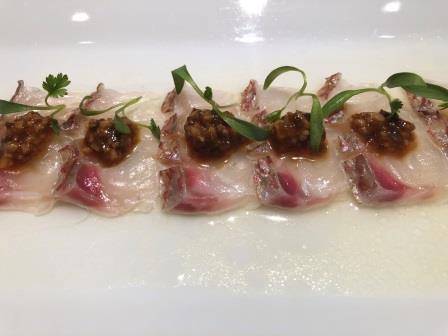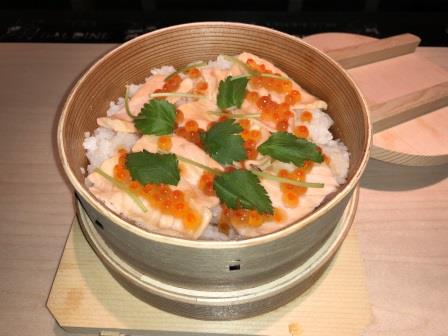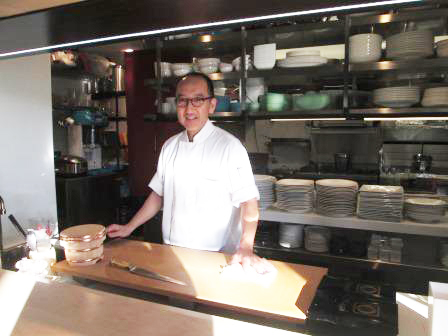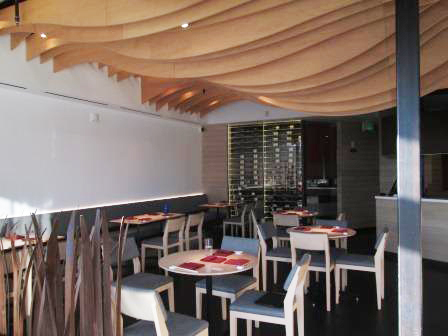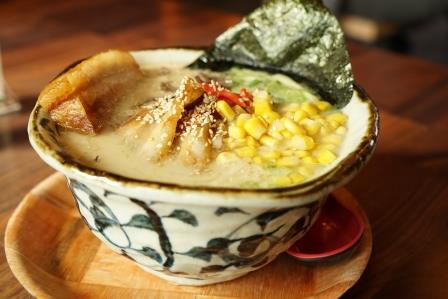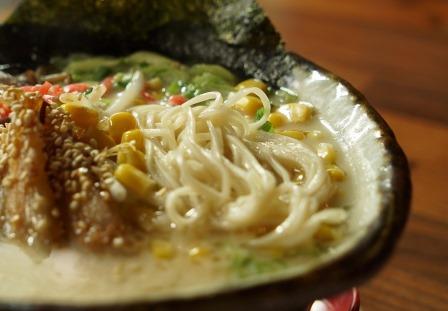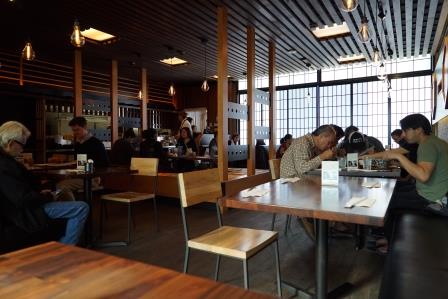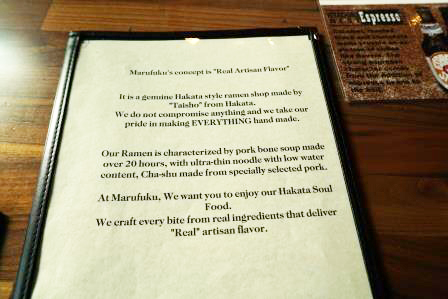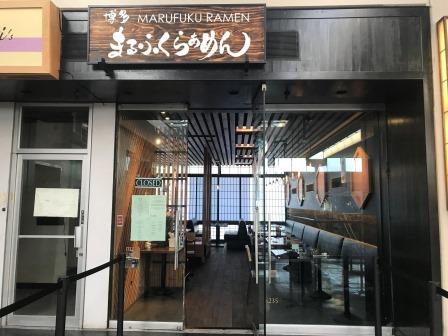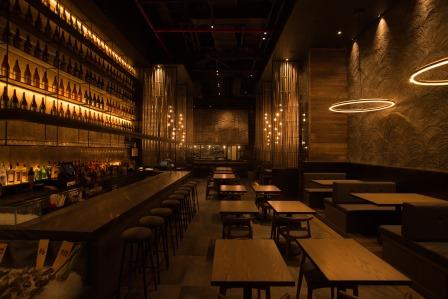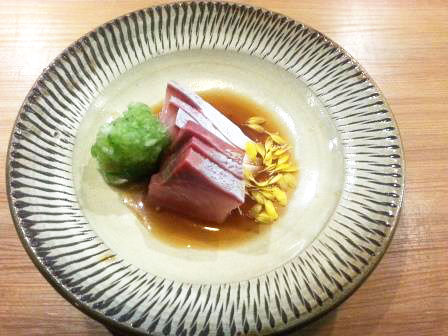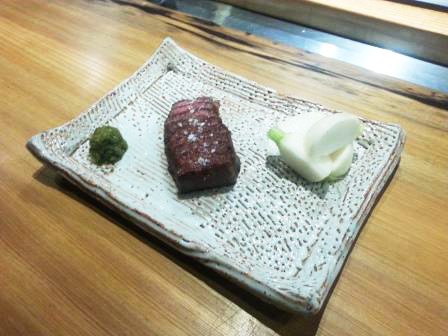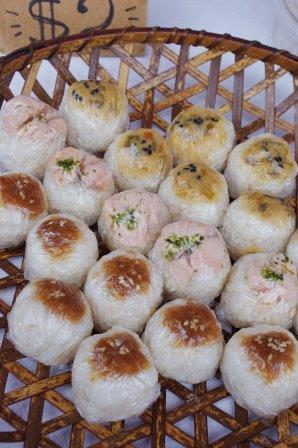A restaurant particular about ingredients, run by a chef from Matsuhisa
By Keiko Fukuda
There is a restaurant on the first floor of a modern building that stands out facing Melrose Avenue. It is UMEDA, run by Mr. Takuya Umeda who used to be a chef at Matsuhisa, and became independent.
There is a pond under the glass floor of the entrance of the restaurant, and the ceiling is designed to look like waving water. You feel the special thoughts of the designer that were put into both the exterior and interior. I heard that the owner of the building took charge of the designing of the building. Mr. Umeda was introduced to this building during its construction.
He was drawn to its good location, and decided to close the deal. At the time, he expected to open the restaurant in about 6 months or so, but it actually took 3 long years to open due to taking a long time to acquire various licenses. You can say that this is a typical hardship that every owner who wants to open a new restaurant in Los Angeles experiences.
Mr. Umeda is from Hokkaido. After working for a restaurant in Sapporo, an acquaintance contacted him about a position opening in a Japanese restaurant in London. He went for the interview because he had always been interested in working overseas. He passed the interview, and got hired in 1987. In 1997, he moved to NOBU London. NOBU London is the second NOBU after NOBU New York was established by the charismatic chef, Nobuyuki Matsuhisa.
After that, Mr. Umeda moved to the Beverly Hills Matsuhisa, andgrew his experience and career under Nobu-san for 20 years. I asked what he absorbed from his master. "I learned from him, the techniques as to how to apply something extremely innovative on something very basic. The way he thinks of how to create something new from ingredients from all over the world that influence him is fantastic".
As such, he finally reached the point of opening the restaurant UMEDA in March of 2017. UMEDA has very extensive menu for both lunch and dinner. The best seller at lunch is the Bento Box ($42). For dinner, in addition to various dinner items, 4 omakase-style dinners are served; tasting ($100), sushi and sashimi ($120), chef's choice ($150), and the highest course which includes a Miyazaki beef dish ($170).
From the stand point of applying innovative arrangements to basic Japanese cuisine, you can say that the Matsuhisa style is deeply embedded into Umeda's cooking. However, now that he became independent, he also tries to develop his own color in his cooking style. Especially with his original sauce, "Koji salsa", to accentuate fish and meat, for instance, he is striving to establish the Umeda style.
Moreover, since he is from Hokkaido, he is particularly picky about seafood ingredients, and many ingredients are sent directly from the Tsukiji market. "You can place orders to Tsukiji directly now, which allows for fresher fish in less time, and cheaper acquisition. Someone actually goes to the market to buy wholesale and send to us, so it is very easy to deal with because we can convey our opinions directly," says Mr. Umeda.
After starting his career in Sapporo, he wandered through various places - London, Beverly Hills, Melrose, and now has 35 years of experience. Umeda-san's idea is to just create the kinds of dishes which are wanted by customers, and would please them. He also shows his flexibility by saying, "If requested by a customer, I would like to challenge it with my experience and knowledge without being conservative and declining to make it, even if it is not a Japanese dish. A new thing could be born unexpectedly like that, couldn't it?"
Lastly, I asked him what kind of restaurant he would like to see UMEDA become 5 years from now. He said, "I would like it to be a place where customers enjoy vividly with their favorite food and drinks - like the image of an English pub." They say that for British people, pubs are an essential part of their lives. I look forward to the day when UMEDA becomes such a place for the people around the Melrose area.
松久出身のシェフが手がける食材にこだわるレストラン
メルローズ・アベニューに面した一際モダンな建物の1階にあるのは、松久のシェフから独立した梅田拓也さんが手がける店、UMEDA 。エントランスのガラスフロアの下には池、店内の天井はまるで波打つようにデザインされている。外観、内観ともにデザイナーのこだわりが感じられる。聞けば、建物のオーナー自身が設計も担当したのだそうだ。梅田さんはこの物件の建設中に案内され、ロケーションに魅力を感じて契約。しかし、半年程度で開店できるだろうと踏んでいたのが、実際は諸々のライセンス取得に時間がかかり、オープニングまでに3年もの年月を要した。ロサンゼルスで新規のレストランを開店させるオーナーには付き物の苦労と言えるかもしれない。
梅田さんは北海道の出身。札幌市内の店で勤務した後に、知り合いからロンドンの日本食店で料理人を探していると声がかかった。以前から海外に興味があったことから迷わず面接を受け、採用された。それが1987 年のことだった。さらに、1997 年にはNOBU ロンドンに転職した。カリスマシェフの松久信幸さん(以下ノブさん)がNOBU ニューヨークに続いて、2号店として手がけた店だ。 その後、梅田さんはビバリーヒルズの松久に移り、20 年にわたってノブさんの下で経験を積んできた。どのようなことを師匠から吸収したかを聞いた。
「ベーシックなものがあって、その上で、非常に斬新なアレンジを施す点を学ばせてもらいました。世界中の食材から影響を受けて、それからいかに新しいものを作り上げるかというアイデアが素晴らしいのです」
こうして、2017 年3月に開店にこぎ着けた UMEDA では、ランチ、ディナーともに多彩なメニューを揃えている。ランチタイムに一番出るのは弁当ボックス(42 ドル)。夜は各種ディナー以外にテイスティング(100 ドル)、寿司と刺身(120 ドル)、シェフズチョイス(150 ドル)、さらに宮崎牛の一品が含まれる最上級コース(170 ドル)の4種類のお任せを提供。
日本料理の基礎の上に斬新なアレンジといった点では、松久スタイルが染み込んでいるとも思える梅田さんの料理だが、独立したからには自分自身の色を料理で出していこうとしている。特にオリジナルのソース「麹サルサ」で魚や肉にアクセントを加えるなど、梅田スタイルの確立に努めているとのこと。
また、北海道出身であることからも魚介のネタにはこだわりがあり、築地直送の食材を多数取り寄せている。「今は直接、築地に注文を入れられるので、鮮度がよく、時間も短く、値段も安くなっています。何より実際に市場で魚を買って卸す人が送ってくるので、どういう魚がほしいかといった、こちらの意見も直接伝わる分、非常にやりやすいです」と梅田さん。
札幌に始まり、ロンドン、ビバリーヒルズ、そしてメルローズと各地を渡り歩きながら、シェフとしての経験は35 年になると言う。そんな梅田さんが理想とするのは、あくまで顧客が食べたいと思う料理、喜んでくれる料理を作ることだと語る。「お客さんがリクエストしてきたら、それは日本料理じゃないからと保守的にならずに、自分の経験と知識を駆使して挑戦したいと思います。新しいものとはそうやって意外なところから生まれるものではないでしょうか」と、フレキシブルな姿勢を見せる。 最後に5年後のUMEDA をどういう店にしたいかを聞くと、「好きな料理とお酒でワイワイと賑やかにお客さんに楽しんでもらえる店にしたいですね。イメージはイギリスのパブです」と梅田さんは答えた。イギリス人の生活にパブはなくてはならないものだと言われるが、メルローズ界隈の人々にとってUMEDA がそういう存在になれることを楽しみに待ちたい。
UMEDA Restaurant
6623 Melrose Ave.
Los Angeles, CA 90038
(323) 965-8010
http://umedarestaurant.com/
Mon.-Sat. 12:00pm-2:30pm
6:00pm-10:30pm
Sunday close
There is a restaurant on the first floor of a modern building that stands out facing Melrose Avenue. It is UMEDA, run by Mr. Takuya Umeda who used to be a chef at Matsuhisa, and became independent.
There is a pond under the glass floor of the entrance of the restaurant, and the ceiling is designed to look like waving water. You feel the special thoughts of the designer that were put into both the exterior and interior. I heard that the owner of the building took charge of the designing of the building. Mr. Umeda was introduced to this building during its construction.
He was drawn to its good location, and decided to close the deal. At the time, he expected to open the restaurant in about 6 months or so, but it actually took 3 long years to open due to taking a long time to acquire various licenses. You can say that this is a typical hardship that every owner who wants to open a new restaurant in Los Angeles experiences.
Mr. Umeda is from Hokkaido. After working for a restaurant in Sapporo, an acquaintance contacted him about a position opening in a Japanese restaurant in London. He went for the interview because he had always been interested in working overseas. He passed the interview, and got hired in 1987. In 1997, he moved to NOBU London. NOBU London is the second NOBU after NOBU New York was established by the charismatic chef, Nobuyuki Matsuhisa.
After that, Mr. Umeda moved to the Beverly Hills Matsuhisa, andgrew his experience and career under Nobu-san for 20 years. I asked what he absorbed from his master. "I learned from him, the techniques as to how to apply something extremely innovative on something very basic. The way he thinks of how to create something new from ingredients from all over the world that influence him is fantastic".
As such, he finally reached the point of opening the restaurant UMEDA in March of 2017. UMEDA has very extensive menu for both lunch and dinner. The best seller at lunch is the Bento Box ($42). For dinner, in addition to various dinner items, 4 omakase-style dinners are served; tasting ($100), sushi and sashimi ($120), chef's choice ($150), and the highest course which includes a Miyazaki beef dish ($170).
From the stand point of applying innovative arrangements to basic Japanese cuisine, you can say that the Matsuhisa style is deeply embedded into Umeda's cooking. However, now that he became independent, he also tries to develop his own color in his cooking style. Especially with his original sauce, "Koji salsa", to accentuate fish and meat, for instance, he is striving to establish the Umeda style.
Moreover, since he is from Hokkaido, he is particularly picky about seafood ingredients, and many ingredients are sent directly from the Tsukiji market. "You can place orders to Tsukiji directly now, which allows for fresher fish in less time, and cheaper acquisition. Someone actually goes to the market to buy wholesale and send to us, so it is very easy to deal with because we can convey our opinions directly," says Mr. Umeda.
After starting his career in Sapporo, he wandered through various places - London, Beverly Hills, Melrose, and now has 35 years of experience. Umeda-san's idea is to just create the kinds of dishes which are wanted by customers, and would please them. He also shows his flexibility by saying, "If requested by a customer, I would like to challenge it with my experience and knowledge without being conservative and declining to make it, even if it is not a Japanese dish. A new thing could be born unexpectedly like that, couldn't it?"
Lastly, I asked him what kind of restaurant he would like to see UMEDA become 5 years from now. He said, "I would like it to be a place where customers enjoy vividly with their favorite food and drinks - like the image of an English pub." They say that for British people, pubs are an essential part of their lives. I look forward to the day when UMEDA becomes such a place for the people around the Melrose area.
松久出身のシェフが手がける食材にこだわるレストラン
メルローズ・アベニューに面した一際モダンな建物の1階にあるのは、松久のシェフから独立した梅田拓也さんが手がける店、UMEDA 。エントランスのガラスフロアの下には池、店内の天井はまるで波打つようにデザインされている。外観、内観ともにデザイナーのこだわりが感じられる。聞けば、建物のオーナー自身が設計も担当したのだそうだ。梅田さんはこの物件の建設中に案内され、ロケーションに魅力を感じて契約。しかし、半年程度で開店できるだろうと踏んでいたのが、実際は諸々のライセンス取得に時間がかかり、オープニングまでに3年もの年月を要した。ロサンゼルスで新規のレストランを開店させるオーナーには付き物の苦労と言えるかもしれない。
梅田さんは北海道の出身。札幌市内の店で勤務した後に、知り合いからロンドンの日本食店で料理人を探していると声がかかった。以前から海外に興味があったことから迷わず面接を受け、採用された。それが1987 年のことだった。さらに、1997 年にはNOBU ロンドンに転職した。カリスマシェフの松久信幸さん(以下ノブさん)がNOBU ニューヨークに続いて、2号店として手がけた店だ。 その後、梅田さんはビバリーヒルズの松久に移り、20 年にわたってノブさんの下で経験を積んできた。どのようなことを師匠から吸収したかを聞いた。
「ベーシックなものがあって、その上で、非常に斬新なアレンジを施す点を学ばせてもらいました。世界中の食材から影響を受けて、それからいかに新しいものを作り上げるかというアイデアが素晴らしいのです」
こうして、2017 年3月に開店にこぎ着けた UMEDA では、ランチ、ディナーともに多彩なメニューを揃えている。ランチタイムに一番出るのは弁当ボックス(42 ドル)。夜は各種ディナー以外にテイスティング(100 ドル)、寿司と刺身(120 ドル)、シェフズチョイス(150 ドル)、さらに宮崎牛の一品が含まれる最上級コース(170 ドル)の4種類のお任せを提供。
日本料理の基礎の上に斬新なアレンジといった点では、松久スタイルが染み込んでいるとも思える梅田さんの料理だが、独立したからには自分自身の色を料理で出していこうとしている。特にオリジナルのソース「麹サルサ」で魚や肉にアクセントを加えるなど、梅田スタイルの確立に努めているとのこと。
また、北海道出身であることからも魚介のネタにはこだわりがあり、築地直送の食材を多数取り寄せている。「今は直接、築地に注文を入れられるので、鮮度がよく、時間も短く、値段も安くなっています。何より実際に市場で魚を買って卸す人が送ってくるので、どういう魚がほしいかといった、こちらの意見も直接伝わる分、非常にやりやすいです」と梅田さん。
札幌に始まり、ロンドン、ビバリーヒルズ、そしてメルローズと各地を渡り歩きながら、シェフとしての経験は35 年になると言う。そんな梅田さんが理想とするのは、あくまで顧客が食べたいと思う料理、喜んでくれる料理を作ることだと語る。「お客さんがリクエストしてきたら、それは日本料理じゃないからと保守的にならずに、自分の経験と知識を駆使して挑戦したいと思います。新しいものとはそうやって意外なところから生まれるものではないでしょうか」と、フレキシブルな姿勢を見せる。 最後に5年後のUMEDA をどういう店にしたいかを聞くと、「好きな料理とお酒でワイワイと賑やかにお客さんに楽しんでもらえる店にしたいですね。イメージはイギリスのパブです」と梅田さんは答えた。イギリス人の生活にパブはなくてはならないものだと言われるが、メルローズ界隈の人々にとってUMEDA がそういう存在になれることを楽しみに待ちたい。
UMEDA Restaurant
6623 Melrose Ave.
Los Angeles, CA 90038
(323) 965-8010
http://umedarestaurant.com/
Mon.-Sat. 12:00pm-2:30pm
6:00pm-10:30pm
Sunday close







